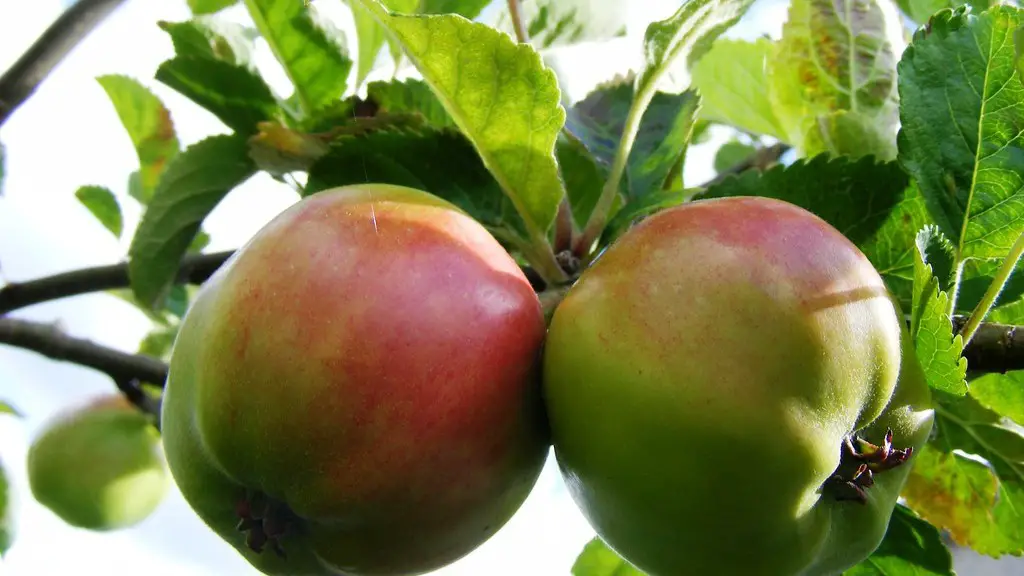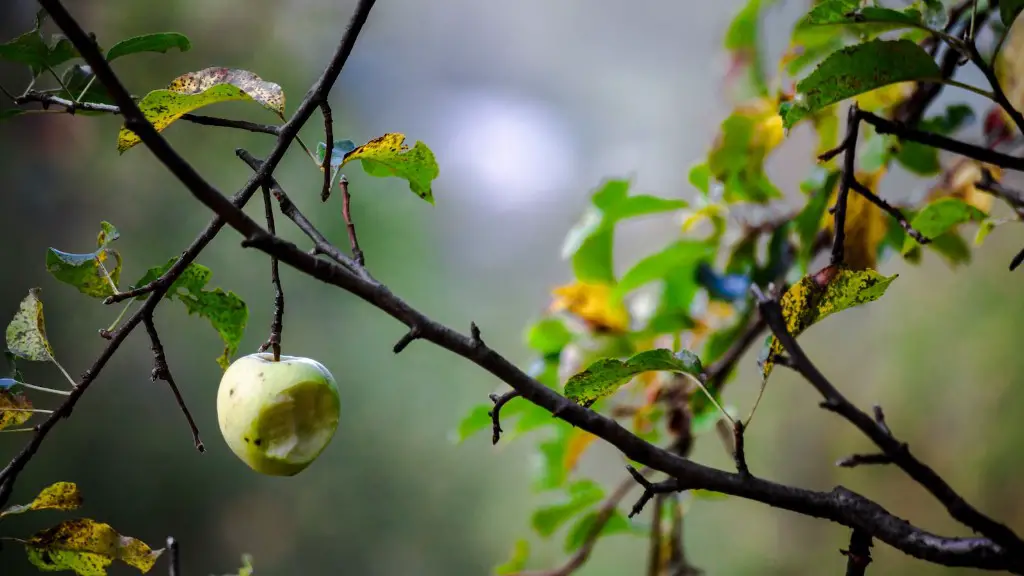Pruning an apple tree is a vital component of maintaining its health and preventing disease. It helps with promoting fruit production and can even increase size and quality of the apples. Though it is necessary to keep up with apple tree pruning, it is important to know when the best time to complete this task is, otherwise it can cause more damage than good. Generally speaking, the best time to prune an apple tree is in late winter or early spring before the tree begins to bloom.
This is beneficial for two main reasons. First, pruning during this time can help to improve air circulation and light penetration, both of which are essential for healthy fruit production and resistance to pests and diseases. Since the tree is in its dormant state, pruning will not require as much effort. Also, pruning while the tree is dormant prevents sap from oozing out, which could attract harmful insects.
In addition to pruning during late winter or early spring, it’s important to wait until after the tree has bloomed in order to identify which limbs need to be cut back. Before cutting back any branches, inspect the tree and look for any obvious signs of disease, insects or excessive growth. Remove any dead, diseased or damaged wood and clean them up with sterilized pruning shears. Do not prune any more than one-third of the total number of branches; you want a balanced tree shape.
Pruning should also be done in small increments and in the correct way. The main branches should be pruned first, followed by thinning out cuts and heading back cuts. Each cut should be angled about 45 degrees away from the bud and the center of the tree. This not only prevents any undesirable water accumulation, but also helps to prevent disease and keeps the tree balanced.
Another necessity to keep in mind while pruning is the size of the limb. Depending on the size and age of the tree, a general rule of thumb is to keep the thickness as less than one-quarter inch. Doing this helps to limit the number of branches and also prevents splitting of the limb.
Part of pruning an apple tree is continuing with the yearly maintenance. Throughout the growing season, remove any water sprouts or sucker growth and thin out the canopy if needed. It’s also important to remove any crossing branches, which can often cause the tree to become overcrowded and lead to more disease. Lastly, inspect the tree frequently and make sure to repair any wounds and thoroughly clean the shears between cuts to avoid introducing diseases.
Disbudding and Tipping
One pruning technique that can help with increasing the size of apples is disbudding, also known as tipping. This involves removing the tips of the stem from which the fruiting spurs form. A fruiting spur is the area of the stem where the buds form the apples. When tipping is done correctly and at the proper time of year, it can help to produce larger apples by limiting the number of buds that can form.
To effectively tip an apple tree, use sharp shears or pruners to snip off the budding tips of the shoots. Often it’s best to start with the inward shoots and work your way outward, pruning the tips of all new growth. Make sure to avoid cutting off any commercial fruit-bearing stems as this can decrease the overall fruiting production.
Tipping an apple tree is an exact science, and it takes a bit of practice to get the timing just right. The ideal timing for disbudding an apple tree is during the late winter months, just before the buds start to swell and flower.
However, it’s important to be aware of the why you are doing it. Disbudding can produce larger apples, but it also has its drawbacks. Primarily, disbudding restricts the number of apples set per fruiting spur, thus reducing the overall quantity of fruit produced. This technique should only be used with the most vigorous varieties to avoid over-restricting the quantity of fruit the tree produces.
In summary, the best time to prune an apple tree is in late winter or early spring, before the tree begins to bloom. Before pruning, inspect the tree to look for any signs of disease, insects or excessive growth. Prune the main limbs first, followed by thinning and heading back cuts, and be aware not to prune more than one-third of the total number of branches, otherwise it can disrupt balance. During the growing season, remove any water sprouts and sucker growth, remove any crossing branches and inspect the tree frequently for wounds. Disbudding should be done in late winter just before the buds start to swell, but be aware that it can produce larger apples, yet reduce overall fruit quality.
Winter Pruning
Late winter is also a great time for winter pruning, which can help to reduce the size and number of shoots, enhance light penetration and improve air circulation through the tree’s canopy. This helps to prevent disease and pests and helps with overall tree health. Winter pruning is done slightly differently than the springtime pruning, and the timing is critical. Typically, the ideal time is late winter when the buds just start to swell and the tree starts to come out of dormancy.
Some of the benefits of winter pruning include reducing the amount of pruning needed in the spring and summer, removing any overcrowded wood and ensuring balanced flower buds and a good crop. The downside is that winter pruning can result in reduced flowering, so it should be used with caution. If done correctly, the tree will quickly adjust to the new pruning and the overall health of the tree can be greatly improved.
When pruning in the winter, there are some things to keep in mind. Make sure to prune only healthy, disease-free wood, and use sharp pruning shears or saws. Winter pruning differs from spring pruning in that it should be thicker stems and longer limbs. Make sure to partially, or completely, remove long limbs that are otherwise out of balance and take off any water sprouts, or young shoots, that originate from the branches.
Winter pruning can also help to rejuvenate an old, neglected tree. If done correctly, it can help to reinvigorate the plant by removing any weak, dead or diseased wood and encouraging strong and healthy limb regrowth.
To summarize, winter pruning is a great way to reduce the size of a tree and improve airflow and light penetration into the canopy. It is best done late in the winter season when the buds just start to swell, and always make sure to prune healthy, disease-free wood. Winter pruning can help with rejuvenating an old tree, however it can also reduce flowering, so it should be used with caution.
Summer Pruning
Summer pruning is another common technique used to control the size of an apple tree. This involves pruning or cutting back any new shoots that have grown during the season. Summer pruning helps to keep the shape of the tree and to reduce the size of overly vigorous shoots or branches. Summer pruning is best done at the beginning or the middle of the season to give the plant time to recover before going into dormancy.
When pruning during the summer months, it is important to remember to only prune healthy wood and to keep the wounds small. This will help keep the tree from developing disease. Also, be aware not to prune more than one-third of the total number of shoots, otherwise it can drastically affect the shape of the tree.
It can be beneficial to prune the inner branches of an apple tree first as this helps to enhance light penetration and prevent overcrowding. During this time, you can also remove any crossing branches, or those that grow at an angle.
It’s also important to include thinning cuts when summer pruning. Thinning out helps to reduce overcrowding and improve air circulation, two issues that can lead to disease and pest damage. During the thinning out process, make sure to partially, or completely, remove long limbs, as well as water sprouts and young shoots.
To conclude, summer pruning helps to control the size of an apple tree and improves its shape. It should be done at the beginning or middle of summer to give the tree time to recover, and it is important to only prune healthy wood and to not prune more than one-third of shoots. This can help to promote healthy fruit production and ward off disease.
Structural Pruning
Structural pruning is one of the most important techniques used in maintaining and shaping an apple tree. This involves selectively cutting certain limbs and branches to improve the structure of the tree and allow for better air and light penetration. Structural pruning is typically done before or after the fruiting season.
When structurally pruning a apple tree it is important to take your time and be selective with the limbs you choose to cut back. It’s best to start by pruning off the limbs at the top of the canopy, aiming for a vase shaped overall structure. Next, gradually prune off some of the inner branches until at least one-quarter of the center of the tree is exposed. This helps with the light penetration and enhances flower and fruit production.
When pruning for structure, it’s best to not remove more than 25% of the tree at a single time. Too much pruning at once can cause more damage than good. Also, it is important to prune and shape the shoots as soon as possible after they have grown. Young shoots are much easier to prune.
Structural pruning also helps with improving soil and water drainage and disease prevention. Make sure to inspect the tree frequently for signs of disease or pests, and do not prune if signs are present. Pruning tools should always be sterilized between uses to avoid introducing diseases.
To summarize, structural pruning is a key component of apple tree maintenance and health. Start by pruning the top of the canopy, followed by inner branches and shoots until at least one-quarter of the center of the tree is exposed. Always be selective with which limbs you choose to prune, and do not remove more than 25% of the tree at a single time. Inspect the tree frequently and sterilize pruning tools between uses to avoid introducing disease.





